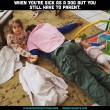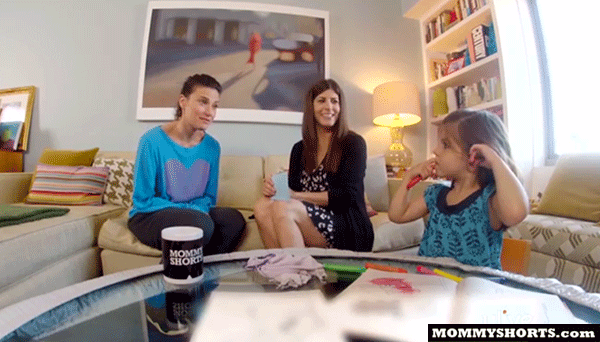 Before I get to today's Dr. B post, I have an announcement. Due to a huge influx in reader-submitted questions and an incredibly busy schedule, Dr. B (our resident early childhood development specialist) will not be accepting any more questions at this time. She will also be cutting back to every other week (which means I'll have to fill the void with more inane Mazzy videos like "The ABCs on Steroids").
Before I get to today's Dr. B post, I have an announcement. Due to a huge influx in reader-submitted questions and an incredibly busy schedule, Dr. B (our resident early childhood development specialist) will not be accepting any more questions at this time. She will also be cutting back to every other week (which means I'll have to fill the void with more inane Mazzy videos like "The ABCs on Steroids").
If you have a question in the cue, Dr. B will get to it eventually or she will answer you privately by email. If your kids have gone off to college by that time, my sincere apologies. This is what I get for offering PHD qualified advice for free.
Which brings me to today's question. Everybody remember Mazzy's dance craze— "Fetch My Sippy Cup, Boy?" Well, it's still catching and has currently infiltrated the home of a mom named Shea. Except her daughter altered the name from "Fetch My" to "Attack Of The". (OUCH!)
Dear Dr. B,
My daughter is 2 years-old. For the last few months, she has been throwing things whenever she wants something or sometimes, just for fun. If she wants more juice in her cup? “Peese?” she asks, then rocket launches the sippy cup at me. If she wants more snacks? “Snacks, peese?” Then with a whoosh I duck the flying snack cup.
Driving is another adventure. We just got home from a 3 week road trip to New England. Needles to say, the car ride was horrific while she was awake. At any given point, you could guarantee being beaned in the back of the head with any assortment of items… sweaty socks, croc shoes, juice cups (which hurt like hell when it's full and nails you dead center).
We have done time-outs, sternly said no and taken away the offending item but none of it has worked. Please help!
Signed, SP (aka Walking MommyTarget)
Dear SP,
Young children use behavior because it serves some important function for them. In your daughter’s case, she may be throwing things for a few reasons: (1) when she wants something; (2) for the fun of seeing how people react; and/or (3) when she is finished with the item but doesn’t know how to tell you.
The use of reactive strategies such as time-out, sternly saying no, and taking away items usually work in the short-term because they provide an immediate consequence and remind her what NOT to do, but often don’t work in the long-term because they don’t teach her what TO DO instead.
The best approach is to be proactive by stopping the behavior before it starts. You have to teach her a more appropriate behavior that serves the same function as quickly and efficiently as throwing.
6 Proactive Ways to Reduce the Throwing Behavior Long-term:
1) Try to anticipate the behavior and respond to her requests quickly: The more you respond before the throw, the more you prevent her from practicing the behavior. You can also think about ways to change the environment to make throwing less likely. For example, if she is throwing toys and food in the car for entertainment, select special car toys that she only plays with in the car so they remain novel and maintain her interest for a longer period. Choose small plush toys with tactile features such as Velcro, soft books or toys that make sounds. Add a playlist of her favorite songs to up your chance of keeping her occupied and interested in an appropriate way. Alternate between different toys every few minutes to prevent her from losing interest (and telling you by throwing it at you!).
2) Positive Redirection: Buy things she can throw at home so that you can positively redirect her to an alternative "throwing" type of activity. Instead of saying "no throwing" after the fact, try to catch her in the act and remind her that "balls are for throwing, not cups". Always follow up by showing her toys or items she is allowed to throw. You can also positively redirect her to tossing soft squishy balls into a container, clothing into the laundry basket, or play a game of catch together.
3) Show and Tell: When she throws something inappropriate, show and tell her what TO DO instead. For example, if she throws her sippy cup, first put it back in her hands or ask her to pick it up, then model for her what to say (e.g., “Milk please”). Have her repeat this phrase before giving her the milk or desired item. If she is throwing things to get your attention when she wants something, show her how to tap your arm or leg gently or teach her to say something like, “Mommy, look” or “Give me please.” If she is throwing when she is finished playing with a toy (such as in the car), put it back in her hand and model saying, “All done,” “finished,” or “take please.” Have her repeat the phrase and then remove the item from her hands.
4) Teach the Positive Opposite of the Behavior: The opposite of throwing is putting something down nicely. Use opportunities of inappropriate throwing, to teach her to place the item down nicely on the table. Model for her how you would like her to place the item down. When she is able to imitate the behavior, be enthusiastic with your praise. Also praise her any time she places items nicely down to increase the likelihood of this appropriate behavior.
5) Use Praise and Natural Reinforcers: If she uses her words instead of throwing or if she places something down nicely, praise her and specifically tell her what she did well. Say, “You put your cup down so nicely!” or “Great job asking mommy for more milk.” If she asks for something the appropriate way, naturally reinforce her efforts by giving her the item she wants. If the item she asks for is off limits, make sure to praise her for good asking first and then explain why she can’t have the item at the moment.
6) Use Natural Consequences: Discourage the behavior naturally by having her fix her mistakes. If she throws her sippy cup, say, “Pick up” in a neutral and calm tone. You may need to teach her to follow this direction by modeling it for her at first. If she spills her milk on the floor, have her help clean it up.
Understand that teaching her what TO DO will take time, practice and repetition before she will catch on. When she throws something but then immediately corrects herself by saying the phrase or showing an appropriate behavior, you will know that you are on the right track.
Be patient and remember that your efforts may not seem as effective at stopping the behavior in the short-term but will be much more effective in the long-term. The good news is, if she is throwing things frequently, she will have more opportunities to learn and practice her new skills and the behavior will go away more quickly.
Also, make sure that all your family members and her caretakers are on the same page and using the same strategies.
Hope this helps!
— Dr. B

























This is a big problem in my house right now. My youngest hits her sister with her cups all the time. Then they start screaming at each other. At some point tears start. It’s really not fun.
I love how all these letters to Dr. B start with “My two-year-old . . . ”
Thank you so much for the reply! The cup throwing has decreased somewhat, mostly because she started daycare last week so she is not really around as much to practice her skills. lol But I appreciate the feedback and will definitely implement it. 🙂
Scary, isn’t it? Four more months until Mazzy reaches the terrible twos and I start having to wear a helmet around the house.
I particularly like #4. I watched my sister (Dr. B) teach Mazzy to *pretend* to eat something instead of actually put it in her mouth. It totally worked. That was months ago and she still does it and then looks at us for a “Very good pretend eating!”
I’m surprised nobody has ever asked a sibling rivalry question. I’ll keep that in mind for future Dr. B posts. And when we get through the current batch!
My son totally does this. Except he throws the sippy cup at my feet instead of my head. A sippy cup slammed into a bare foot (particularly a toe) is really painful too!
I’ve been assaulted many times with sippy cups, shoes, books but last weekend was the worst. Imagine driving home, kids eating their lollipops the cashier gave them and hearing ‘Mommy!! CATCH!!’ followed by a big, wet, sticky lollipop to the back of the head. There was lots of crying, from me. The kids looked traumatized.
i love Dr.B Tips and post. thanks
Where can I buy i
Please let me know if you’re looking for a author for your
blog. You have some really great posts and I think I would be a good asset.
If you ever want to take some of the load off, I’d love to write some articles for your blog in exchange for a link back to mine.
Please shoot me an e-mail if interested. Kudos!